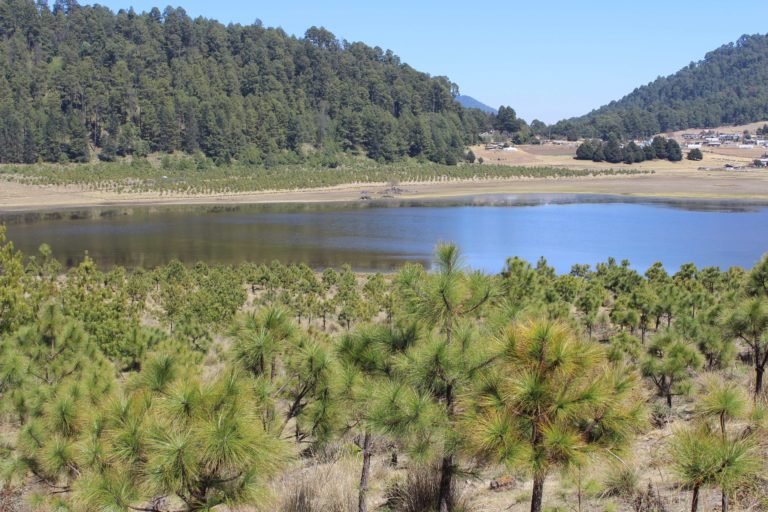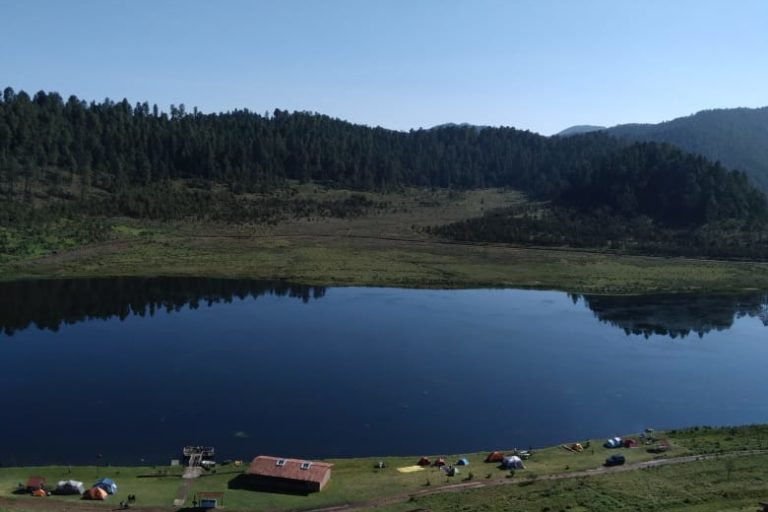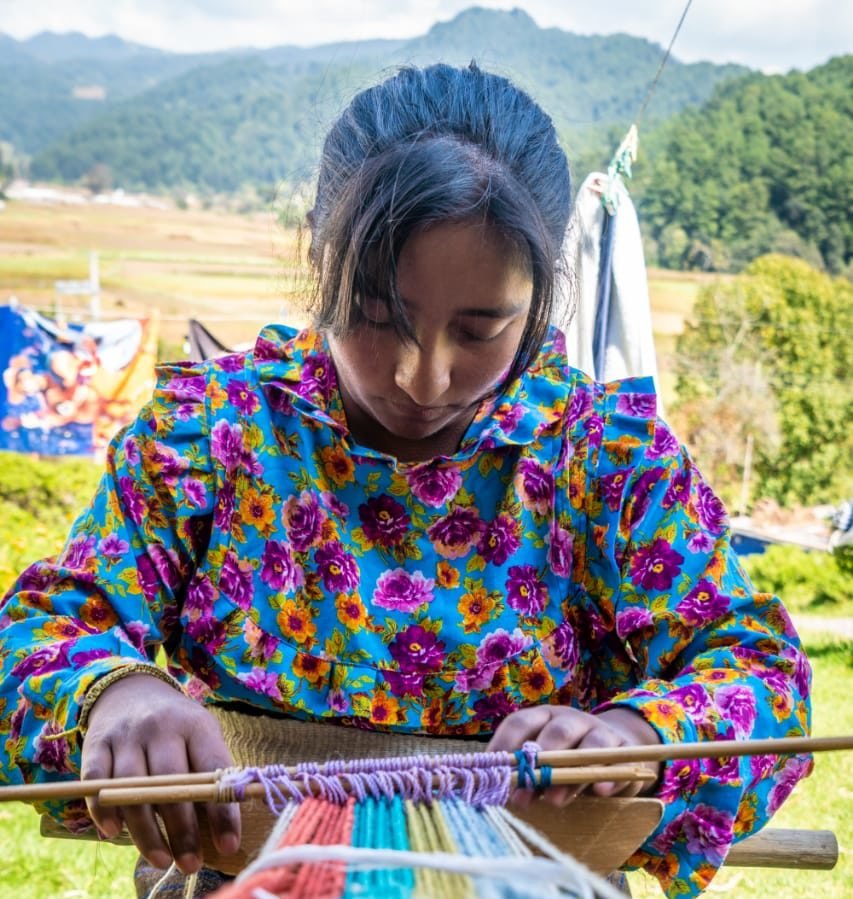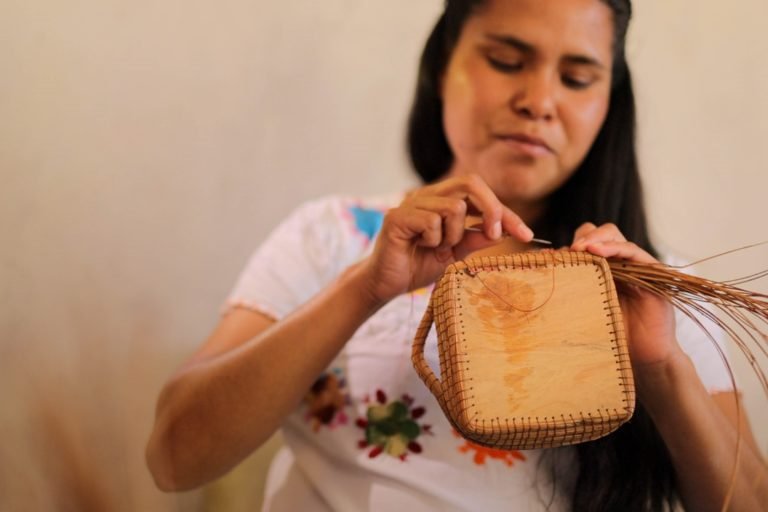- In the Amanalco-Valle de Bravo region of central Mexico, Indigenous and local communities responsible for more than 8,000 hectares (19,700 acres) of forests have banded together to develop and promote ecotourism projects.
- They offer a wide range of activities and workshops to both generate revenue for the community and to educate visitors on their way of life and the importance of nature.
- On top of creating jobs, the communities want to encourage a type of tourism that combines conservation of their forests, lakes and waterfalls.
When she was a child, Cruz Ávila used to walk through the forest as part of her daily routine. She would pick wood or medicinal plants. She learned to find birds hidden in the branches and to identify the different trees. She also found that walking among the pines and listening to a waterfall is good medicine for the soul and the body.
Several months ago, she and other residents from forest communities in the Amanalco-Valle de Bravo Basin, in central Mexico, decided to transform these walks into one of the main attractions of their community forest. Their aim is to create alternative sources of livelihood, preserve the forest, and show that responsible tourism is possible.
The first step was to get training. For four months in 2021, Ávila and other community members attended workshops for training as nature guides. The next step was to consolidate the community alliance and create a local chapter of the Board of Coordinated Indigenous Peoples for the Forest and Tourism (POCBOTU).
POCBOTU brings together communities and members of ejidos, or communally managed lands, responsible for more than 8,000 hectares (19,700 acres) of forests in the state of México. The alliance was born in 2020 from the Mexican Civil Council for Sustainable Forestry (CCMSS), an NGO that has worked in the area for two decades.
“There were more and more visitors coming to this area and the communities had an interest to develop tourism activities, but their offering was always similar: huts and zip lines,” says Andrés Juárez, coordinator for the Amanalco region at the CCMSS. “The alarms went off because those tourists don’t care about the forest or the community resources. And by offering the same thing, the ejidos were competing against, instead of supporting, each other.”
The organization brought the issue to the locals, who were also concerned about tourism damaging their forests and natural resources. According to Juárez, that’s how the CCMSS and the ejidos and communities started working on a project for sustainable rural tourism.

Allying tourism with conservation
The Amanalco-Valle de Bravo Basin is especially important because of the environmental services that it provides through the more than 35,000 hectares (86,500 acres) of temperate forests and more than 1,770 bodies of water in the region.
The area contributes to carbon sequestration and, consequently, to climate change mitigation. In addition, it’s home to emblematic species like the monarch butterfly (Danaus plexippus). To top it off, 10% of the water consumed in Mexico City comes from this region.
The Amanalco-Valle del Bravo Basin is also an important tourist area that receives around 2 million visitors per year, thanks to its proximity to Mexico City, who are drawn here for its temperate forests with waterfalls and lakes.

In recent years, residents of the forest communities have suffered from the consequences of a growing tourism industry that’s not environmentally sustainable. For example, some visitors access community forests and natural lakes with all-terrain vehicles that can damage the landscape.
One of the affected water bodies is El Sumidero, a lake and important water system that’s home to Ambystoma rivulare salamanders (closely related to the better-known axolotls), acocil crayfish (Cambarellus montezumae) and other species.
According to Andrés Juárez, there’s also been pushback against the communal ownership of the land in an effort to get it privatized and sold for cattle ranches and hotels.

The ejido representatives and the communities that are part of POCBOTU discussed these issues at meetings held in 2021.
Juárez says the communities agreed to create an alliance to face the companies promoting damaging activities in the forests, and, more importantly, to push for a tourism model that aids in the conservation of the community forests.
As part of this alliance, they designed a manifest for community tourism, in which they committed to balanced tourism for the conservation of their ecosystems and the preservation of their forests. In addition, they want respect for their ejidos and communal lands, and have thus called for an end to real estate speculation in the region.

In early April 2022, the communities presented their alliance officially. One of the people presenting it was Cruz Ávila. Her voice echoed the feelings shared by many who are part of this project for forests and tourism.
“To us, forests are our home, the place where we were born. We want to take care of them as we take care of our home,” she said. “We are working together to keep the forests alive, the forests healthy, the forests beautiful. We invite hikers and tourist to come see our house, to get to know and enjoy this place with respect and care.”

A range of community alternatives
Ávila says she joined the CCMSS workshops as a personal challenge. “I never thought I’d be a guide. It seemed very complicated,” she says.
As part of the training, she learned about the history of her ejido, the different types of trails, group management dynamics, biocultural experiences, and first aid and risk prevention.
In the workshops, each trainee guide developed their own project and each ejido and community had to define the tourist activities they’d offer.
“We saw that each ejido had something special to give so that the offerings were diversified and we wouldn’t compete against each other,” says Beatriz Hilario Cruz, the treasurer for the Sendero San Lucas Amanalco ecotourism park. “We learned from those who already have services for tourism, and together, as a block, we [can] stop this tourism that doesn’t want to respect and learn from the forests.”

Some of the ejidos participating in the initiative already have experience with ecotourism. For example, San Lucas Amanalco has been receiving visitors for four years. The community has 400 hectares (988 acres) of forest, a suspension bridge, two waterfalls, and paths for cycling.
Amanalco de Becerra is another ejido with a history of sustainable tourism. This community has operated a park since 2002, where it offers visitors huts, rental speedboats, kayaks, guided treks, a restaurant, and a multipurpose room.
“Although we are already on a good track, this alliance seems very viable to have the neighboring ejidos join and grow the offerings for responsible tourism that isn’t disorderly,” says Ramón Fierro Ponce, president of the Amanalco de Becerra ejido board.

The San Jerónimo ejido is in the first stages of the project. This community, with 132 hectares (326 acres) of common-use forest, grows corn, peas and beans, and makes pulque, a traditional drink, as well as bread and handicrafts. The residents are betting on agritourism and rural tourism as new sources of livelihood.
“The forest, water and know-how of our people are the primary pillars of our tourist activities,” says Beatriz Pedroza Marcos, president of the San Jerónimo ejido board. “We want to show what we are and how we live, how we work to take care of our forest so that the visitors gain awareness about the need to protect them.”
Their plan is to offer workshops to visitors about the activities they carry out, she says. “We are betting on tourists who are interested in knowing this, who appreciate the forest and those who live in the communities,” Pedroza says.

The San Jerónimo, Capilla Vieja and San Miguel Tenextepec ejidos share the lake of El Sumidero. To protect it, residents of these communities have agreed to ban access to all-terrain vehicles.
Ávila says her community, San Miguel Tenextepec, has developed a sustainable tourism plan based on hiking and workshops that showcase local activities. In addition, they plan to have a viewing platform ready by 2023.
There are other sustainable tourism offerings underway as part of the POCBOTU initiative, ranging from bird-watching to observation of fireflies, to sightseeing the monarch butterflies as they arrive in some of the communities for the winter.

Caring for the forests and creating jobs
One of the alliance’s objectives is involving young people in the planning and development of tourism projects to engage them in jobs in the communities.
Vicente Jacobo Ramírez was one of 29 people taking part in the workshop to become a nature guide. He says he’s been involved in guiding tour groups since 2018 and is relying on the POCTOBU initiative to generate more work.
“Here a lot of young people migrate, or they leave and come back for periods of time. Being a guide is an activity that has allowed me to stay and have a good income,” he says.
“Now I have good expectations with the board. There will be more projects and I’ll have more opportunities to obtain an income doing what I like: meeting people, talking to them and disseminating the importance of protecting our forests,” Ramírez says.
The alliance is currently aiming to create 60 permanent jobs.

Ávila says she plans to start promoting her hiking project. “I’m going to take visitors to a place called El Caballero, and halfway through, with the other neighbors, we’ll offer them a workshop on making pulque and bread,” she says. “In the same house we’ll offer typical breakfasts to bring benefits to the ejidatarios [ejido members] who join.”
The communities in this alliance have another thing in common: they practice sustainable timber harvesting by following a forest management program authorized by the environmental authorities. The program establishes how many trees they can cut and lays out activities they can do to keep the forest in good condition.
Ávila says many people mistake community forest management for just logging. She says that’s not the case. “We take a lot of time to preserve [the forests]. Every year we dedicate up to 40 days per person to collective work.”
She says she trusts the tourism initiative will receive support from visitors who are willing to learn about community forest management, how the communities live, to walk among pines and oyamel firs, and, above all, to contribute to the conservation of their forests.
Banner image: Members of POCBOTU in the Amanalco-Valle de Bravo Basin. Image by Francisco Guadarrama Olivera.
This story was reported by Mongabay’s Latam team and first published here on our Latam site on May 9, 2022.













